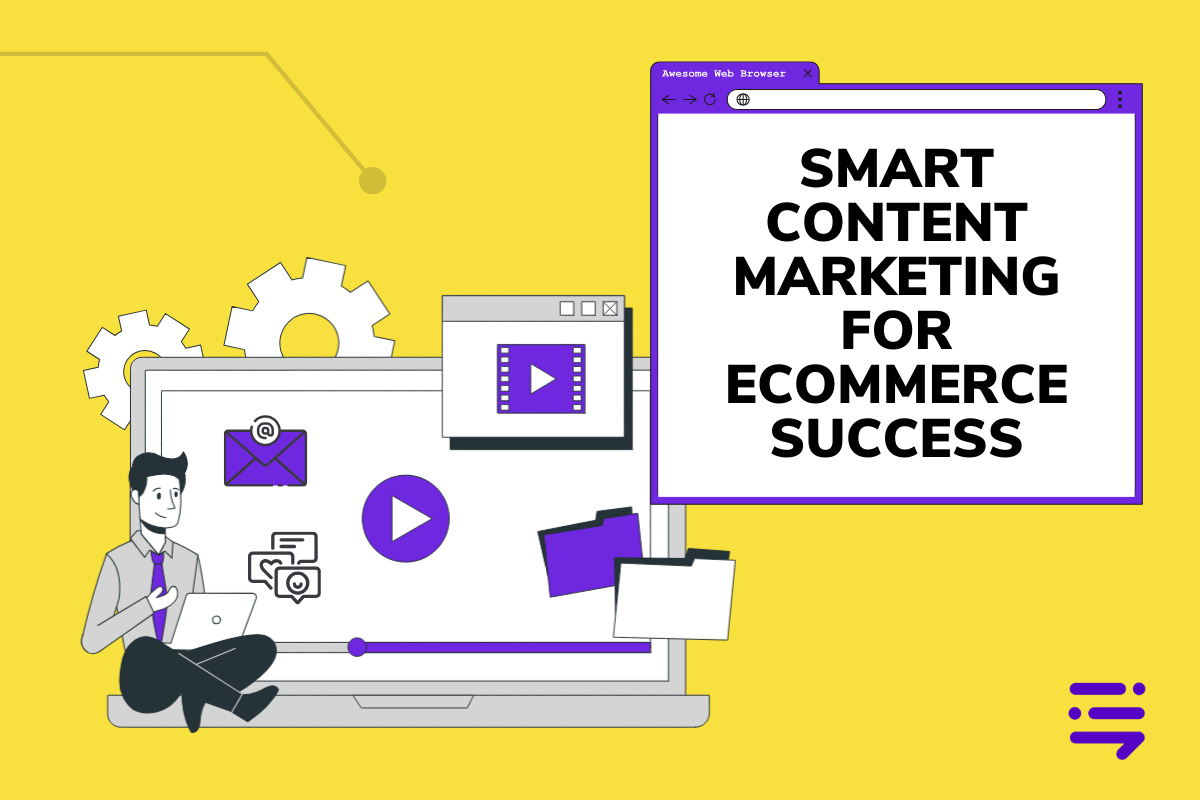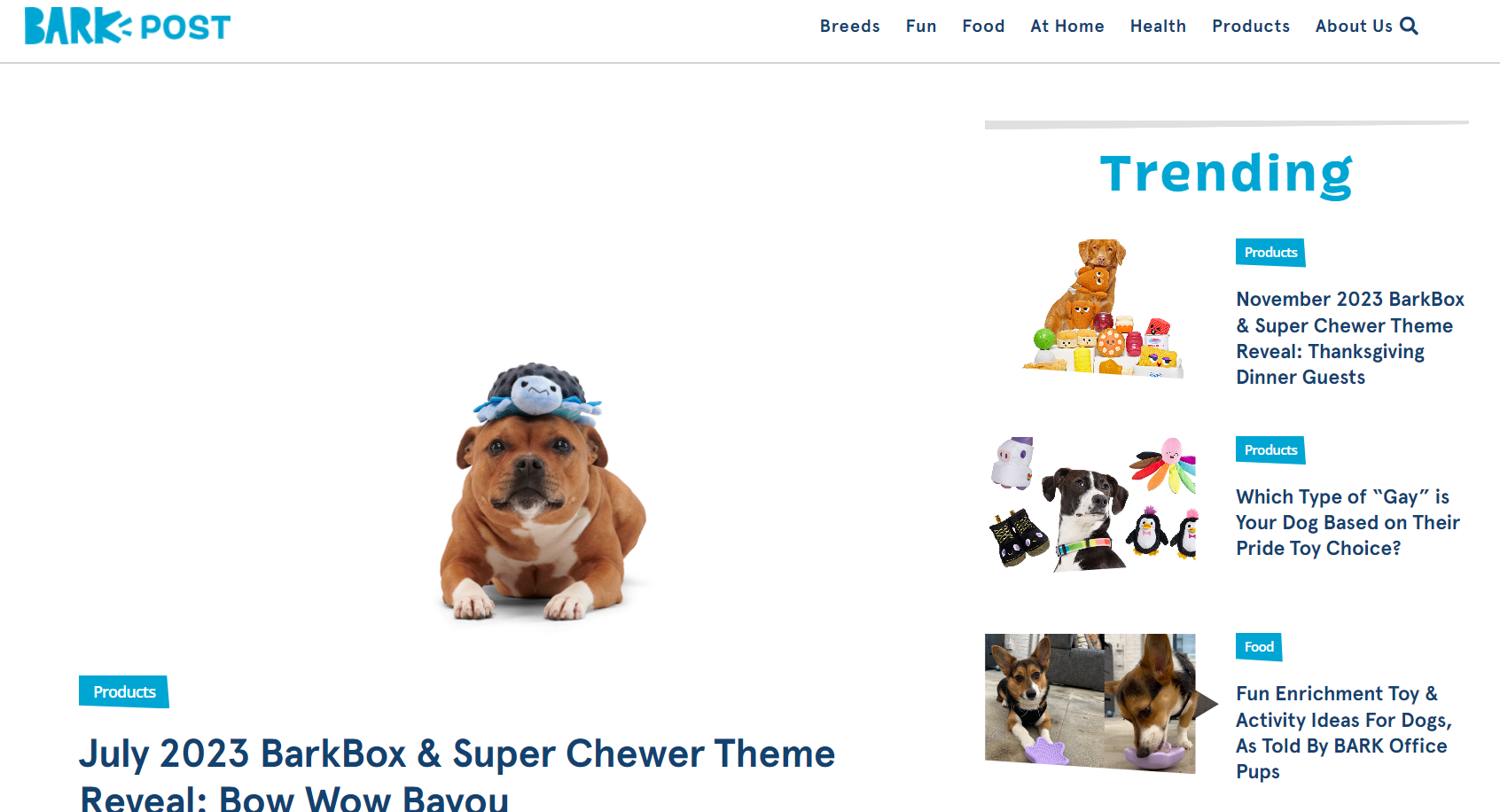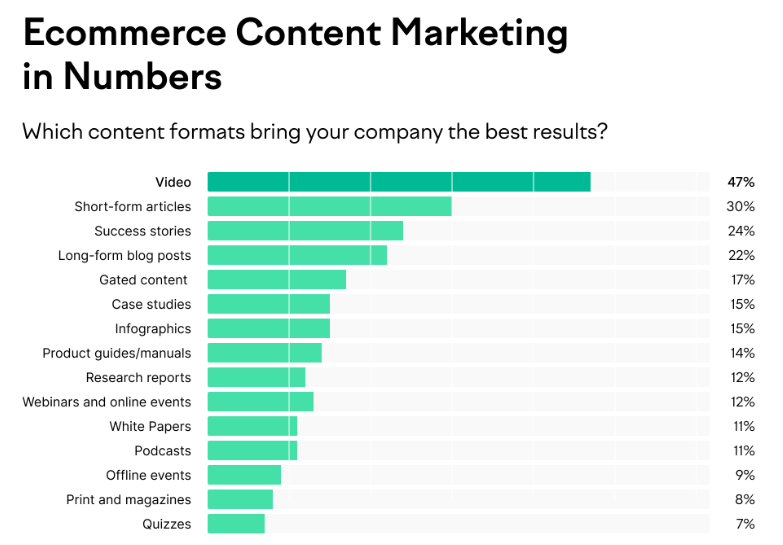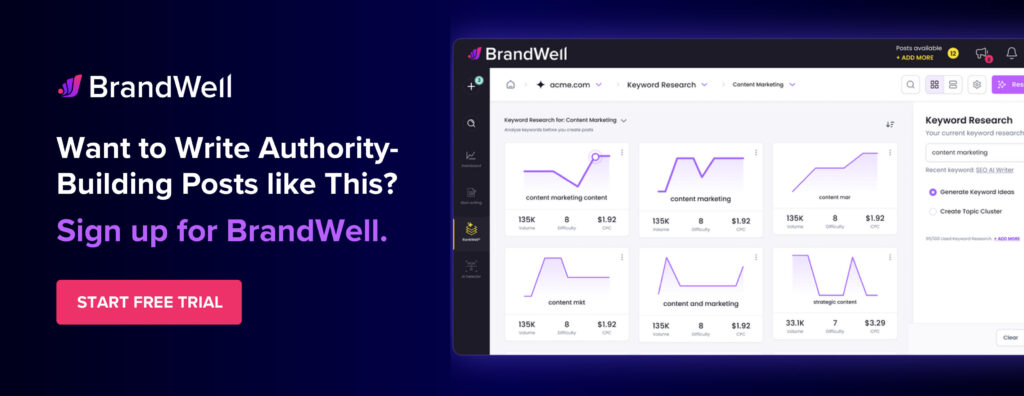Discover top guides, trends, tips and expertise from AIO Writers

Content marketing for ecommerce isn’t just about pushing products; it’s creating content that people actually want to engage with. Think of it as sharing useful tips, interesting stories, or helpful guides that resonate with your audience.
Whether it’s through blog posts, social media updates, or videos, the goal is to provide value while subtly showcasing what you offer. By understanding what your audience cares about and tailoring your content to meet their needs, you’re not just attracting visitors to your online store – you’re building lasting relationships that can lead to more sales and loyalty in the long run.
In this guide, we’ll explore innovative ecommerce content marketing examples from top brands to inspire your own strategy. You’ll learn how to build content marketing campaigns that engage and convert, measure their success accurately, and navigate common challenges with ease.
As a bonus, we’ll look into the best content marketing tools that every entrepreneur must have at their disposal.
Are you prepared to turn casual window shoppers into committed purchasers? Let’s make sure your brand’s voice is heard loud and clear in the bustling online marketplace.
Table Of Contents:
- Content Marketing for Ecommerce
- Winning Ecommerce Content Marketing Strategies
- Create Content That Evokes Emotions
- Find Topics That Get The Most Social Shares
- Write In-Depth Articles
- Create a Content Hub
- Embrace Video Content
- Feature Product Photos in Your Content
- Publish Buying Guides
- Create Interactive Content
- Use Effective Calls To Action
- Make Your Content Shareable
- Build Comparison Pages
- Offer an FAQ Page or Help Center
- Measuring Ecommerce Content Marketing ROI
- Top Tools: Content Marketing for Ecommerce Made Easy
- Navigating Challenges in Your Content Strategy
- FAQs – Content Marketing for Ecommerce
- Conclusion
Content Marketing for Ecommerce
Picture the digital marketplace as a bustling city. Your ecommerce store? Just one of many shops lining the streets, each vying for attention. In the bustling digital marketplace, it’s content marketing that turns your shop window into a magnet, pulling passersby through your virtual door.
But what exactly makes content marketing for ecommerce so vital?
It’s all about building relationships.
Traditional advertising shouts from the rooftops, while content marketing sits down for coffee with your audience, getting to know them on a personal level.
Crafting content transcends mere creation; it involves weaving tales that strike a chord with what your audience craves and cherishes. Think of it as being less of a salesperson and more of an insightful friend who recommends products because they genuinely improve lives.
To see this strategy in action, let’s look at a few brands that have successfully implemented content marketing for ecommerce.
Studio McGee
Studio McGee‘s approach towards content marketing not only showcases its products but also serves as a guide for those looking to infuse beauty into their living spaces. Their blog is more than just a digital showroom — it’s a treasure trove of inspiration and practical advice for anyone eager to transform their home. Each post is carefully written to resonate with readers’ aspirations of creating aesthetically pleasing environments, using Studio McGee’s designs and products as references.

BarkBox
BarkBox, a beloved subscription service for dogs and their owners, exemplifies how to leverage content marketing for ecommerce effectively. Their strategy revolves around creating engaging, keyword-focused content that appeals directly to dog lovers everywhere. Bark Post serves as a central hub where users can discover everything from trending products and upcoming box themes to fun and informative blogs tailored specifically for their furry friends. This approach not only drives traffic but also establishes BarkBox as a thought leader in the pet industry.

Warby Parker
Warby Parker changed the eyewear industry not just with its direct-to-consumer model but also through compelling storytelling. Their yearly summary goes beyond mere statistics, weaving a captivating tale of expansion, obstacles overcome, and future aspirations. Their strategy demonstrates how sharing behind-the-scenes stories can create a deeper connection with customers.

For further inspiration, read our full-length guide on ecommerce content marketing examples.
Winning E-commerce Content Marketing Strategies
Did you know that over 2.7 billion people are shopping online in 2024? With this number on the rise, e-commerce companies worldwide are facing tougher competition to grab attention and turn browsers into loyal customers. Your brand’s success rides on how well you can impress potential customers online.
One of the smartest and most cost-effective ways to grab the attention of prospective buyers is by creating valuable content. This could take the form of blog posts, infographics, videos, and emails, depending on your products and your audience’s preferences.
Here are some winning content marketing strategies to boost your e-commerce business.
Create Content That Evokes Emotions
Emotionally charged content has the power to connect on a deeper level with your audience, driving engagement and sharing. In the realm of e-commerce, where competition is fierce and attention spans are short, leveraging emotions can be a game-changer for your content marketing strategy.
Content evoking strong emotions like awe, amusement, anxiety, or anger tends to get shared more often. This insight is invaluable for digital commerce experts, as it underscores the importance of creating content that resonates emotionally with potential customers. By tapping into these feelings, brands can foster a sense of connection and community among their audience.
How to write emotion-driven content:
- Tell compelling stories: Narratives that include challenges or personal triumphs tend to evoke empathy and inspiration.
- Use visuals: Images and videos can convey emotion much faster than text alone. Use visuals that complement your message to amplify its emotional impact.
- Incorporate user-generated content: Sharing real stories from satisfied customers not only adds authenticity but also leverages the powerful emotions associated with personal experiences.
Find Topics That Get The Most Social Shares
In content marketing for e-commerce, understanding what resonates with your audience is crucial. One effective strategy to gauge this is by analyzing which topics and headlines are garnering the most social shares. Tools like BuzzSumo serve as a treasure trove for marketers, providing insights into content performance across various platforms.
Enter relevant keywords or phrases related to your niche and BuzzSumo will present a list of articles that have achieved significant engagement on social media channels.
For instance, if an article on “Best tactics to grow your online sales” tops the chart, consider how you can inject a fresh perspective on this topic.
One of the best content marketing tools for e-commerce is HubSpot’s Blog Ideas Generator. By entering up to five nouns related to your business or industry, HubSpot generates potential titles designed to engage readers and drive traffic.
Write In-Depth Articles
One content marketing strategy that stands out consistently is writing in-depth articles. These comprehensive pieces, often exceeding 2,000 words, delve deeply into topics to provide readers with a rich source of information and insight.
Another significance of writing long-form blog posts is that Google’s algorithms are designed to prioritize content that offers a thorough explanation of a particular topic. This means that longer articles have the potential not only to rank higher but also to become authoritative references in their respective niches.
How to create compelling long-form content:
- Research thoroughly: Begin with an exhaustive research phase. Use tools like Ahrefs or Semrush to identify gaps in existing content and opportunities for new insights.
- Dive into case studies: Incorporate real-world examples that are relevant to your topic. If you’re writing about content marketing for e-commerce, then e-commerce content marketing case studies showcasing successful content marketing campaigns can significantly enhance credibility and reader engagement.
- List down actionable insights: Readers love actionable advice they can implement immediately. Break down complex ideas into bulleted lists or step-by-step instructions when possible.
Beyond just length and depth, ensuring readability is crucial. Use headings and subheadings throughout your article for better navigation by both users and search engines alike.
Moreover, integrating multimedia elements such as infographics or videos related specifically to e-commerce scenarios could further enrich your long-form content’s appeal.
Create a Content Hub
Imagine a digital space where all your valuable content is neatly organized by topics relevant to your brand and your audience. That’s what we call a content hub.
Instead of presenting your blog in a traditional chronological order, a content hub offers specific categories, making it easier for users to find precisely what they need, regardless of where they are in their buyer’s journey.
The goal of content hubs is simple: to solve problems and provide valuable information for both new and potential customers. These hubs can house various content types like blog posts, downloadable templates, quizzes, and more.
Embrace Video Content
Video content is taking over the online world, with platforms like YouTube becoming go-to destinations for engaging and entertaining content.
Videos are a powerhouse in content strategy, especially for e-commerce brands. They educate customers about products and guide them through the sales funnel.
According to a study by Lemonlight, a whopping 94% of people use video to make purchasing decisions. It’s clear – video content is gold for e-commerce.
The possibilities are endless when it comes to showcasing your products through video content, from how-to guides to expert reviews.

Source: Semrush
Feature Product Photos in Your Content
It may seem obvious, but integrating product photos into your content is crucial.
Since you’re selling products, highlighting them whenever possible is essential. Display high-quality product photos on product pages, social media, and blog posts to showcase your offerings. Hire a professional photographer if necessary.
Publish Buying Guides
Buying guides are a smart strategy for e-commerce companies to subtly introduce their products to potential customers.
As customers near the end of their buying journey, they compare products and seek information to aid their decision-making process.
Buying guides provide essential details like price, features, and functionality, helping customers make informed decisions. You can even tailor guides for specific occasions like holidays.
Create Interactive Content
One advantage e-commerce has over other industries — like finance, for example — is the visual appeal of its content.
E-commerce content tends to be more entertaining. Thus, embracing creative, interactive content types becomes pivotal in drawing customers to your site.
Creative content formats like infographics, quizzes, downloadable templates, and generators are incredibly effective in attracting customers to your site.
Take advantage of these visually engaging formats to make your content stand out.
Use Effective Calls To Action
A well-placed call-to-action (CTA) not only guides your audience on what to do next but also significantly boosts conversion rates, playing a pivotal role in achieving an impressive e-commerce content marketing ROI.
How do you write CTAs that convert?
Keep it simple: A cluttered page with multiple calls to action can overwhelm visitors, leading them away from making a decision. Using a single call to action per page ensures that your message is clear and focused, guiding users precisely where you want them – whether it’s subscribing to a newsletter or adding products to their cart.
Capture attention with contrast: The visual design of your CTA buttons plays an integral role in capturing user attention. An effective strategy involves using contrasting colors between the button and its background — think bright orange-yellow against a serene blue backdrop. This contrast principle isn’t just about aesthetics; it’s rooted in psychology, enhancing visibility and drawing eyes toward the action you want users to take.
Customize CTAs for each content type: Different types of content serve various stages of the customer journey – from awareness through consideration to decision-making. Tailor your CTAs accordingly: use “Learn More” for informational blog posts aiming at early-stage buyers or “Buy Now” for product pages targeting ready-to-purchase visitors. Aligning your CTAs with content intent not only enhances user experience but also drives targeted actions more effectively.
Make Your Content Shareable
Creating outstanding content is only half the battle; ensuring it’s shareable is equally important.
Shareable content not only increases brand exposure but also earns valuable backlinks, boosting your SEO efforts.
By making your content easily shareable, you can attract more eyes to your brand for years to come.
Build Comparison Pages
While creating comparison pages may not be the first thing on your content creation list, they’re incredibly effective for e-commerce websites.
Comparison pages help potential buyers choose your products over competitors. By optimizing these pages with relevant keywords, you increase visibility and attract customers actively comparing products.
Offer an FAQ Page or Help Center
A frequently asked questions (FAQ) page is a simple yet invaluable tool for e-commerce brands.
While not the flashiest content type, FAQ pages are incredibly useful. They answer common customer queries, build trust, improve site navigation, boost search engine rankings, and establish your brand’s authority.
You certainly wouldn’t want a potential customer to leave your site and opt for a competitor simply because they couldn’t find the answer they were seeking.
Measuring E-commerce Content Marketing ROI
Measuring the ROI (return on investment) of e-commerce content marketing involves tracking various metrics to gauge the effectiveness of your efforts.
Here’s a quick guide on how to measure e-commerce content marketing ROI:
Set Clear Objectives: Define specific goals for your content marketing efforts. These could include increasing website traffic, improving conversion rates, boosting sales, enhancing brand awareness, or growing customer engagement.
Track Key Metrics: Determine the key performance indicators (KPIs) that align with your objectives. Some common metrics to track include:
- Website traffic: Measure the number of visitors to your site and their behavior.
- Conversion rate: Track the percentage of visitors who complete a desired action, such as making a purchase or signing up for a newsletter.
- Revenue: Monitor the direct revenue generated from your content marketing efforts.
- Customer engagement: Assess metrics like social media engagement, email open rates, and time spent on site.
- Brand mentions and sentiment: Monitor brand mentions and sentiment on social media and other online channels to gauge brand perception.
Attribution Modeling: Use attribution modeling to attribute conversions and revenue to specific content marketing initiatives. This helps determine which content channels and types are driving the most value.
Calculate Costs: Determine the costs associated with creating and promoting your content, including production costs, ad spending, and employee salaries.
Calculate ROI: Once you have tracked your key metrics and costs, calculate the ROI using the following formula:
ROI = (Net Profit/Total Costs) x 100
- Net Profit = Revenue generated from content marketing – Total Costs
- Total Costs = Costs associated with creating and promoting content
Analyze and Iterate: Analyze the results of your content marketing campaigns and identify areas for improvement. Adjust your strategies and tactics based on the insights gained from your ROI analysis.
By following these steps and continuously refining your approach, you can effectively measure the ROI of your e-commerce content marketing efforts and optimize your campaigns for greater success.
Top Tools: Content Marketing for Ecommerce Made Easy
Content marketing tools can help streamline your e-commerce content marketing efforts, from creating compelling content to distributing it effectively and analyzing its performance to drive continuous improvement.
But finding the right tools can feel like searching for a needle in a haystack. Here are some of the best content marketing for e-commerce tools that can be game-changers.
Content Creation Magic
- BrandWell: An AI powerhouse tool for writing blog posts, product descriptions, landing pages, ad copy, social media posts, and other marketing material. If you’re selling on Shopify, syncing your content is easy with BrandWell’s Shopify plugin.
- Canva: Canva is a user-friendly design tool that offers a wide range of templates. E-commerce businesses can use Canva to create eye-catching product images, promotional banners, and social media graphics to showcase products and engage with customers.
- Adobe Creative Cloud: Adobe Creative Cloud offers a suite of design tools including Photoshop, Illustrator, and InDesign, catering to more advanced content creation needs such as designing custom product images, branding materials, and multimedia content that stand out from the competition.
- Grammarly: Grammarly is an AI-powered writing assistant that helps ensure product descriptions, blog posts, and other written content are free from grammatical errors and typos, enhancing professionalism and credibility.
- BuzzSumo: BuzzSumo is a content research tool that provides insights into popular content topics, trends, and keywords, helping marketers and entrepreneurs generate ideas for their business blogs.
Distribution Channels Unlocked
- Buffer: Buffer is a social media management platform that allows business owners to schedule, publish, and analyze content across various social media channels. Buffer also provides insights into key social media metrics such as engagement, reach, clicks, and shares, enabling e-commerce stores to track the performance of their social media content and optimize their strategy accordingly.
- Hootsuite: Hootsuite is another social media management platform that offers features for scheduling multiple posts at once, saving time and effort in content planning and distribution. Hootsuite’s monitoring tools allow ecommerce businesses to track mentions, hashtags, and keywords relevant to their industry, enabling them to engage with customers, monitor brand sentiment, and identify trends in real time.
- Mailchimp: Mailchimp is an email marketing platform that helps e-commerce brands set up automated email campaigns triggered by specific customer actions, such as abandoned cart reminders, order confirmations, and product recommendations, helping to drive sales and improve customer retention. Mailchimp offers robust segmentation and personalization features, allowing marketers to target their email campaigns based on customer demographics, purchase history, and preferences, resulting in higher engagement and conversion rates.
Analyzing Your Success Stories
- Google Analytics: Google Analytics is a powerful web analytics tool that provides detailed insights into website traffic, user behavior, and conversion metrics. It allows ecommerce sites to track sales, transactions, and conversion rates so they can measure the effectiveness of their content marketing campaigns and website optimization efforts.
- Hotjar: Hotjar is a behavior analytics tool that offers features such as heatmaps, session recordings, and user surveys to help businesses understand how visitors interact with their stores. Hotjar’s heatmaps visualize user interaction data, showing where visitors click, scroll, and move their mouse on a webpage, helping e-commerce stores identify areas of interest and optimize the layout and design for better conversion.
- Moz: Moz is an SEO software suite that offers tools for keyword research, rank tracking, backlink analysis, and website optimization. E-commerce brands can find relevant keywords with high search volume and low competition, helping them optimize product listings, blog content, and category pages for improved search engine visibility.
- Sprout Social: Sprout Social’s social listening tools allow e-commerce stores to monitor brand mentions, hashtags, and keywords on social media platforms, enabling them to identify trends, track sentiment, and engage with customers in real time. Sprout Social provides detailed analytics on social media performance, including engagement metrics, audience demographics, and content effectiveness, helping e-commerce brands measure the impact of their social media efforts and optimize their strategy for better results.
Navigating Challenges in Your Content Strategy
Every e-commerce brand faces its own set of content marketing hurdles. But, the good news? Each one has a solution.
Generating High-Quality Content Consistently
Maintaining a steady stream of high-quality content can be challenging, especially for small e-commerce brands with limited resources.
Solution: Automate your content creation with an AI tool like BrandWell. This powerful software solution can generate all types of content — from blog posts to product descriptions — in just a few clicks! Plus, the in-app content calendar helps you plan your content strategy months ahead. Consider repurposing existing content or curating user-generated content to ensure a consistent flow of fresh marketing materials.
Standing Out in a Saturated Market
With countless e-commerce stores vying for consumers’ attention, it can be difficult to differentiate your brand and content from competitors.
Solution: Focus on creating unique, valuable content that resonates with your target audience. Identify your unique selling proposition (USP) and emphasize it in your blog posts and product pages. Utilize storytelling, visual elements, and personalized messaging to engage and captivate your audience.
Driving Traffic and Engagement
Attracting visitors to your e-commerce website and keeping them engaged with your content can be a constant struggle. How do you draw more visitors to your e-commerce site?
Solution: Invest in search engine optimization (SEO) to improve your website’s visibility in search engine results and drive organic traffic. Leverage social media platforms, email marketing, influencer partnerships, and paid advertising to promote your content and reach a wider audience. And don’t forget to encourage user engagement through interactive content, contests, polls, and user-generated content.
Measuring ROI and Effectiveness
Determining e-commerce content marketing ROI can be challenging, especially without clear metrics and tracking mechanisms in place.
Solution: Set specific, measurable goals for your content marketing campaigns, such as increasing website traffic, improving conversion rates, or boosting sales. Use analytics tools like Google Analytics, social media insights, and CRM systems to track key performance indicators (KPIs) and measure the effectiveness of your content. Continuously analyze and optimize your content strategy based on the insights gained from data analysis.
Adapting to Changing Trends and Algorithms
The digital landscape is constantly evolving, with changes in consumer behavior, technology, and search engine algorithms impacting content marketing strategies. How do you keep up?
Solution: Stay informed about industry trends, consumer preferences, and algorithm updates through ongoing research and monitoring. Remain agile and adaptable, and be prepared to adjust your content strategy accordingly. Experiment with new formats, channels, and tactics to stay ahead of the curve and maintain relevance with your audience. Lastly, regularly review and update your content to ensure it remains timely and relevant.
FAQs – Content Marketing for E-commerce
What is e-commerce content marketing?
E-commerce content marketing involves crafting and sharing valuable, relevant content to attract and engage online shoppers, nudging them toward making a purchase.
How can I set up content marketing for my e-commerce store?
Start by understanding your audience. Then create engaging, useful content that solves their problems or answers their questions. Share it widely across channels they frequent.
What is a content marketing strategy in e-commerce?
A solid e-commerce content strategy outlines what you’ll communicate, through which mediums, and how it’ll drive shopper engagement and sales over time.
What are the 5 C’s of e-commerce marketing?
The 5 C’s are Content (what you’re offering), Context (how it fits into the customer’s life), Community (building relationships), Convenience (ease of access), and Conversation (engaging with customers).
Conclusion
Throughout this comprehensive guide on content marketing for e-commerce, you’ve seen how it’s not just about selling but telling a story that resonates with audiences.
You’ve been inspired by top brands and got inspired to craft your own compelling campaigns. Remember, engagement drives sales.
You now know measuring success isn’t just numbers; it’s understanding impact.
And when challenges pop up? You’re ready with solutions.
Having the correct tools at your disposal can utterly transform how you tackle obstacles. They let you create, distribute, and analyze like a pro.
Content marketing is an indispensable tool for e-commerce success in today’s competitive landscape. By creating valuable, engaging content tailored to your audience’s needs and preferences, you can attract, engage, and convert customers, drive traffic to your website, and build brand loyalty.
Ready to revolutionize your e-commerce content strategy? Sign up for BrandWell today and unlock the potential of next-level content creation!

UNLOCK YOUR POTENTIAL
Long Headline that highlights Value Proposition of Lead Magnet
Grab a front row seat to our video masterclasses, interviews, case studies, tutorials, and guides.



